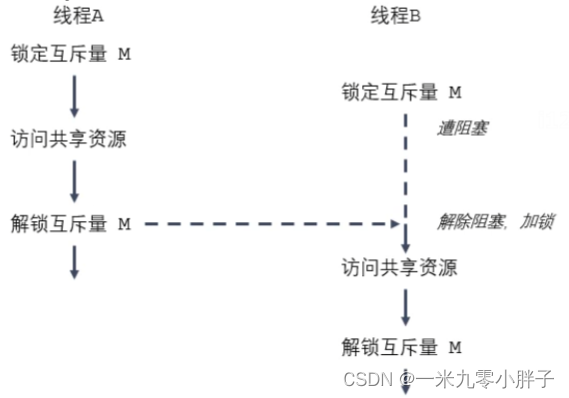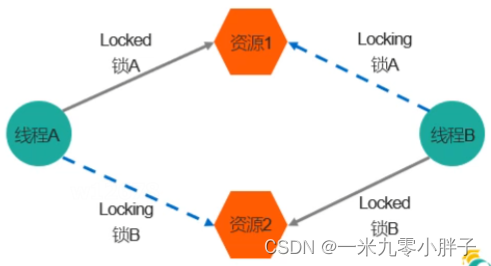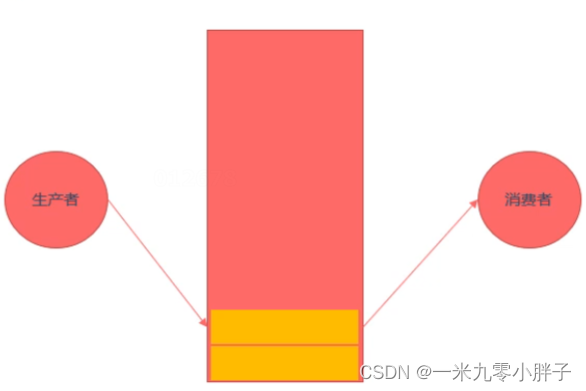
Linux 多线程开发(附有案例代码)
同一个程序中的所有线程均会独立执行相同程序,且共享同一份全局内存区域,其中包括初始化数据段、未初始化数据段,以及堆内存段。(传统意义上的UNIX进程只是多线程程序的一个特例,该进程只包含一个线程)调用fork()来创建进程的代价相对较高,即便利用写时复制技术,仍热需要复制诸如内存页表和文件描述符表之类的多种进程属性,这意味着fork()调用在时间上的开销依然不菲。进程间的信息难以共享。由于除去只读
一、线程概述
1、线程概念
与进程(process)类似,线程(thread)是允许应用程序并发执行多个任务的一种机制。一个进程可以包含多个线程。同一个程序中的所有线程均会独立执行相同程序,且共享同一份全局内存区域,其中包括初始化数据段、未初始化数据段,以及堆内存段。(传统意义上的 UNIX进程只是多线程程序的一个特例,该进程只包含一个线程)
进程是 CPU 分配资源的最小单位,线程是操作系统调度执行的最小单位。
线程是轻量级的进程(LWP: Light weight Process),在 Linux 环境下线程的本质仍是进程。
查看指定进程的 LWP 号:ps -Lf pid
2、线程和进程的区别
进程间的信息难以共享。由于除去只读代码段外,父子进程并未共享内存,因此必须采用一些进程间通信方式,在进程间进行信息交换。
调用fork()来创建进程的代价相对较高,即便利用写时复制技术,仍热需要复制诸如内存页表和文件描述符表之类的多种进程属性,这意味着fork()调用在时间上的开销依然不菲。
线程之间能够方便、快速地共享信息。只需将数据复制到共享(全局或堆)变量中即可。创建线程比创建进程通常要快 10 倍甚至更多。线程间是共享虚拟地址空间的无需采用写时复制来复制内存,也无需复制页表。
3、线程之间共享和非共享资源
(1)共享资源
进程ID和父进程ID
进程组ID和会话ID
用户ID和用户组工D
文件描述符表、信号处置
文件系统的相关信息:文件权限掩码(umask) 和当前工作目录
虚拟地址空间(除栈、.text)
(2)非共享资源
线程ID
信号掩码
线程特有数据
error变量
实时调度策略和优先级
栈,本地变量和函数的调用链接信息
二、线程相关函数
pthread_t pthread_self(void);
int pthread_equal(pthread_t t1, pthread_t t2);
int pthread_create(pthread_t *thread,const pthread_attr_t *attr,void * (*start_routine) (void * ), void *arg);
void pthread_exit (void *retval);
int pthread_join(pthread_t thread,void * *retval);
int pthread_detach (pthread_t thread);
int pthread_cancel(pthread_t thread);
1、线程创建
(1)线程创建函数 pthread_create 详解
一般情况下,main函数所在的线程我们称之为主线程(main线程),其余创建的线程
称之为子线程。
程序中默认只有一个进程,fork()函数调用,2进行
程序中默认只有一个线程,pthread_create()函数调用,2个线程。
#include <pthread.h>
int pthread_create(pthread_t *thread, const pthread_attr_t *attr,
void *(*start_routine) (void *), void *arg);
- 功能:创建一个子线程
- 参数:
- thread:传出参数,线程创建成功后,子线程的线程ID被写到该变量中。
- attr : 设置线程的属性,一般使用默认值,NULL
- start_routine : 函数指针,这个函数是子线程需要处理的逻辑代码
- arg : 给第三个参数使用,传参
- 返回值:
成功:0
失败:返回错误号。这个错误号和之前errno不太一样。
获取错误号的信息: char * strerror(int errnum);(2)线程创建函数 pthread_create 案例
#include <stdio.h>
#include <pthread.h>
#include <string.h>
#include <unistd.h>
void * callback(void * arg) {
printf("child thread...\n");
printf("arg value: %d\n", *(int *)arg);
return NULL;
}
int main() {
pthread_t tid;
int num = 10;
// 创建一个子线程
int ret = pthread_create(&tid, NULL, callback, (void *)&num);
if(ret != 0) {
char * errstr = strerror(ret);
printf("error : %s\n", errstr);
}
for(int i = 0; i < 5; i++) {
printf("%d\n", i);
}
sleep(1);
return 0; // exit(0);
}2、线程终止
(1)线程终止函数 pthread_exit 详解
#include <pthread.h>
void pthread_exit(void *retval);
功能:终止一个线程,在哪个线程中调用,就表示终止哪个线程
参数:
retval:需要传递一个指针,作为一个返回值,可以在pthread_join()中获取到。
pthread_t pthread_self(void);
功能:获取当前的线程的线程ID
int pthread_equal(pthread_t t1, pthread_t t2);
功能:比较两个线程ID是否相等
不同的操作系统,pthread_t类型的实现不一样,有的是无符号的长整型,有的
是使用结构体去实现的。(2)线程终止函数 pthread_exit 案例
#include <stdio.h>
#include <pthread.h>
#include <string.h>
void * callback(void * arg) {
printf("child thread id : %ld\n", pthread_self());
return NULL; // pthread_exit(NULL);
}
int main() {
// 创建一个子线程
pthread_t tid;
int ret = pthread_create(&tid, NULL, callback, NULL);
if(ret != 0) {
char * errstr = strerror(ret);
printf("error : %s\n", errstr);
}
// 主线程,和父子进程一样,主线程和子线程也是交替执行
for(int i = 0; i < 1000; i++) {
printf("%d\n", i);
}
printf("tid : %ld, main thread id : %ld\n", tid ,pthread_self());
// 让主线程退出,当主线程退出时,不会影响其他正常运行的线程。
pthread_exit(NULL);
printf("main thread exit\n"); //主线程推出后,其后面的内容便不再执行
return 0; // exit(0);
}3、连接已终止线程
(1) 连接已终止线程函数 pthread_join 详解
#include <pthread.h>
int pthread_join(pthread_t thread, void **retval);
- 功能:和一个已经终止的线程进行连接
回收子线程的资源
这个函数是阻塞函数,调用一次只能回收一个子线程
一般在主线程中使用
- 参数:
- thread:需要回收的子线程的ID
- retval: 接收子线程退出时的返回值
- 返回值:
0 : 成功
非0 : 失败,返回的错误号(2) 连接已终止线程函数 pthread_join 案例
#include <stdio.h>
#include <pthread.h>
#include <string.h>
#include <unistd.h>
int value = 10;
void * callback(void * arg) {
printf("child thread id : %ld\n", pthread_self());
// sleep(3);
// return NULL;
// int value = 10; // 局部变量
pthread_exit((void *)&value); // return (void *)&value;
}
int main() {
// 创建一个子线程
pthread_t tid;
int ret = pthread_create(&tid, NULL, callback, NULL);
if(ret != 0) {
char * errstr = strerror(ret);
printf("error : %s\n", errstr);
}
// 主线程
for(int i = 0; i < 5; i++) {
printf("%d\n", i);
}
printf("tid : %ld, main thread id : %ld\n", tid ,pthread_self());
// 主线程调用pthread_join()回收子线程的资源
int * thread_retval;
//子线程结束后才会调用,也即阻塞
ret = pthread_join(tid, (void **)&thread_retval);
if(ret != 0) {
char * errstr = strerror(ret);
printf("error : %s\n", errstr);
}
printf("exit data : %d\n", *thread_retval);
printf("回收子线程资源成功!\n");
// 让主线程退出,当主线程退出时,不会影响其他正常运行的线程。
pthread_exit(NULL);
return 0;
}4、分离线程
(1)分离线程函数 pthread_detach 详解
#include <pthread.h>
int pthread_detach(pthread_t thread);
- 功能:分离一个线程。被分离的线程在终止的时候,会自动释放资源返回给系统。
1.不能多次分离,会产生不可预料的行为。
2.不能去连接一个已经分离的线程,会报错。
- 参数:需要分离的线程的ID
- 返回值:
成功:0
失败:返回错误号(2)分离线程函数 pthread_detach 案例
#include <stdio.h>
#include <pthread.h>
#include <string.h>
#include <unistd.h>
void * callback(void * arg) {
printf("chid thread id : %ld\n", pthread_self());
return NULL;
}
int main() {
// 创建一个子线程
pthread_t tid;
int ret = pthread_create(&tid, NULL, callback, NULL);
if(ret != 0) {
char * errstr = strerror(ret);
printf("error1 : %s\n", errstr);
}
// 输出主线程和子线程的id
printf("tid : %ld, main thread id : %ld\n", tid, pthread_self());
// 设置子线程分离,子线程分离后,子线程结束时对应的资源就不需要主线程释放
ret = pthread_detach(tid);
if(ret != 0) {
char * errstr = strerror(ret);
printf("error2 : %s\n", errstr);
}
// 设置分离后,对分离的子线程进行连接 pthread_join()
// ret = pthread_join(tid, NULL);
// if(ret != 0) {
// char * errstr = strerror(ret);
// printf("error3 : %s\n", errstr);
// }
pthread_exit(NULL);
return 0;
}5、线程取消
(1)线程取消函数 pthread_cancel 详解
#include <pthread.h>
int pthread_cancel(pthread_t thread);
- 功能:取消线程(让线程终止)
取消某个线程,可以终止某个线程的运行,
但是并不是立马终止,而是当子线程执行到一个取消点,线程才会终止。
取消点:系统规定好的一些系统调用,我们可以粗略的理解为从用户区到内核区的切换,这个位置称之为取消点。(2)线程取消函数 pthread_cancel 案例
#include <stdio.h>
#include <pthread.h>
#include <string.h>
#include <unistd.h>
void * callback(void * arg) {
printf("chid thread id : %ld\n", pthread_self());
for(int i = 0; i < 5; i++) {
printf("child : %d\n", i);
}
return NULL;
}
int main() {
// 创建一个子线程
pthread_t tid;
int ret = pthread_create(&tid, NULL, callback, NULL);
if(ret != 0) {
char * errstr = strerror(ret);
printf("error1 : %s\n", errstr);
}
// 取消线程
pthread_cancel(tid);
for(int i = 0; i < 5; i++) {
printf("%d\n", i);
}
// 输出主线程和子线程的id
printf("tid : %ld, main thread id : %ld\n", tid, pthread_self());
pthread_exit(NULL);
return 0;
}三、线程属性
1、线程属性相关函数
int pthread_attr_init(pthread_attr_t *attr);
- 初始化线程属性变量
int pthread_attr_destroy(pthread_attr_t *attr);
- 释放线程属性的资源
int pthread_attr_getdetachstate(const pthread_attr_t *attr, int *detachstate);
- 获取线程分离的状态属性
int pthread_attr_setdetachstate(pthread_attr_t *attr, int detachstate);
- 设置线程分离的状态属性2、线程属性相关函数案例
#include <stdio.h>
#include <pthread.h>
#include <string.h>
#include <unistd.h>
void * callback(void * arg) {
printf("chid thread id : %ld\n", pthread_self());
return NULL;
}
int main() {
// 创建一个线程属性变量
pthread_attr_t attr;
// 初始化属性变量
pthread_attr_init(&attr);
// 设置属性
pthread_attr_setdetachstate(&attr, PTHREAD_CREATE_DETACHED);
// 创建一个子线程
pthread_t tid;
int ret = pthread_create(&tid, &attr, callback, NULL);
if(ret != 0) {
char * errstr = strerror(ret);
printf("error1 : %s\n", errstr);
}
// 获取线程的栈的大小
size_t size;
pthread_attr_getstacksize(&attr, &size);
printf("thread stack size : %ld\n", size);
// 输出主线程和子线程的id
printf("tid : %ld, main thread id : %ld\n", tid, pthread_self());
// 释放线程属性资源
pthread_attr_destroy(&attr);
pthread_exit(NULL);
return 0;
}四、线程同步
(1)线程同步
线程同步的几种方式:互斥锁、死锁、读写锁;
线程的主要优势在于,能够通过全局变量来共享信息。不过,这种便捷的共享是有代价的:必须确保多个线程不会同时修改同一变量,或者某一线程不会读取正在由其他线程修改的变量。
临界区是指访问某一共享资源的代码片段,并且这段代码的执行应为原子操作(即当前线程没有把整个流程执行一遍时,别的线程不能抢占资源),也就是同时访问同一共享资源的其他线程不应终端该片段的执行。
线程同步:即当有一个线程在对内存进行操作时,其他线程都不可以对这个内存地址进行操作,直到该线程完成操作,其他线程才能对该内存地址进行操作,而其他线程则处于等待状态。
(2)线程同步案例
/*
主线程不干活,创建多个线程,并发执行某一件事 。
使用多线程实现买票的案例。
有3个窗口,一共是100张票。
*/
#include <stdio.h>
#include <pthread.h>
#include <unistd.h>
// 全局变量,所有的线程都共享这一份资源。
int tickets = 100;
void * sellticket(void * arg) {
// 卖票
while(tickets > 0) {
usleep(6000);
printf("%ld 正在卖第 %d 张门票\n", pthread_self(), tickets);
tickets--;
}
/*
同一个线程必须把下列三行代码执行一遍,另一个线程才能抢占
usleep(6000);
printf("%ld 正在卖第 %d 张门票\n", pthread_self(), tickets);
tickets--;
*/
return NULL;
}
int main() {
// 创建3个子线程
pthread_t tid1, tid2, tid3;
pthread_create(&tid1, NULL, sellticket, NULL);
pthread_create(&tid2, NULL, sellticket, NULL);
pthread_create(&tid3, NULL, sellticket, NULL);
// 回收子线程的资源,阻塞
pthread_join(tid1, NULL);
pthread_join(tid2, NULL);
pthread_join(tid3, NULL);
// 设置线程分离。
// pthread_detach(tid1);
// pthread_detach(tid2);
// pthread_detach(tid3);
pthread_exit(NULL); // 退出主线程
return 0;
}说明:同一个线程必须把整个流程执行一遍,另一个线程才能抢占;上述案例中多个线程同时操作了共享数据;
五、互斥锁/互斥量
1、互斥量
(1)为避免线程更新共享变量时出现问题,可以使用互斥量(mutex是mutual exclusion的缩写)来确保同时仅有一个线程可以访问某项共享资源。可以使用互斥量来保证对任意共享资源的原子访问。
(2)互斥量有两种状态:已锁定(locked)和未锁定(unlocked)。任何时候至多只有一个线程可以锁定该互斥量。试图对已经锁定的某一互斥量再次加锁,将可能阻塞线程或者报错失败,具体取决于加锁时使用的方法。
(3)一旦线程锁定互斥量,随即成为该互斥量的所有者,只有所有者才能给互斥量解锁。一般情况下,对每一共享资源(可能由多个相关变量组成)会使用不同的互斥量,每一线程在访问同一资源时将采用如下协议:
针对共享资源锁定互斥量
访问共享资源
对互斥量解锁
(4)如果多个线程试图执行这一块代码(一个临界区),事实上只有一个线程能够持有该互斥量(其他线程将遭到阻塞),即同时只有一个线程能够进入这段代码区域,如下图所示:

2、互斥量相关操作函数
互斥量的类型 pthread_mutex_t
int pthread_mutex_init(pthread_mutex_t *restrict mutex, const pthread_mutexattr_t *restrict attr);
- 初始化互斥量
- 参数 :
- mutex : 需要初始化的互斥量变量
- attr : 互斥量相关的属性,NULL
- restrict : C语言的修饰符,被修饰的指针,不能由另外的一个指针进行操作。
pthread_mutex_t *restrict mutex = xxx;
pthread_mutex_t * mutex1 = mutex;
int pthread_mutex_destroy(pthread_mutex_t *mutex);
- 释放互斥量的资源
int pthread_mutex_lock(pthread_mutex_t *mutex);
- 加锁,阻塞的,如果有一个线程加锁了,那么其他的线程只能阻塞等待
int pthread_mutex_trylock(pthread_mutex_t *mutex);
- 尝试加锁,如果加锁失败,不会阻塞,会直接返回。
int pthread_mutex_unlock(pthread_mutex_t *mutex);
- 解锁3、互斥锁的相关案例
#include <stdio.h>
#include <pthread.h>
#include <unistd.h>
// 全局变量,所有的线程都共享这一份资源。
int tickets = 1000;
// 创建一个互斥量
pthread_mutex_t mutex;
void * sellticket(void * arg) {
// 卖票
while(1) {
// 加锁
pthread_mutex_lock(&mutex);
if(tickets > 0) {
usleep(6000);
printf("%ld 正在卖第 %d 张门票\n", pthread_self(), tickets);
tickets--;
}else {
// 解锁
pthread_mutex_unlock(&mutex);
break;
}
// 解锁
pthread_mutex_unlock(&mutex);
}
return NULL;
}
int main() {
// 初始化互斥量
pthread_mutex_init(&mutex, NULL);
// 创建3个子线程
pthread_t tid1, tid2, tid3;
pthread_create(&tid1, NULL, sellticket, NULL);
pthread_create(&tid2, NULL, sellticket, NULL);
pthread_create(&tid3, NULL, sellticket, NULL);
// 回收子线程的资源,阻塞
pthread_join(tid1, NULL);
pthread_join(tid2, NULL);
pthread_join(tid3, NULL);
pthread_exit(NULL); // 退出主线程
// 释放互斥量资源
pthread_mutex_destroy(&mutex);
return 0;
}六、死锁
1、死锁
两个或两个以上的进程在执行过程中,因争夺共享资源而造成的一种互相等待的现象,若无外力作用,它们都将无法推进下去。此时称系统处于死锁状态或系统产生了死锁。
多线程多锁,抢占锁资源

2、死锁案例
#include <stdio.h>
#include <pthread.h>
#include <unistd.h>
// 创建2个互斥量
pthread_mutex_t mutex1, mutex2;
void * workA(void * arg) {
pthread_mutex_lock(&mutex1);
sleep(1);
pthread_mutex_lock(&mutex2);
printf("workA....\n");
pthread_mutex_unlock(&mutex2);
pthread_mutex_unlock(&mutex1);
return NULL;
}
void * workB(void * arg) {
pthread_mutex_lock(&mutex2);
sleep(1);
pthread_mutex_lock(&mutex1);
printf("workB....\n");
pthread_mutex_unlock(&mutex1);
pthread_mutex_unlock(&mutex2);
return NULL;
}
int main() {
// 初始化互斥量
pthread_mutex_init(&mutex1, NULL);
pthread_mutex_init(&mutex2, NULL);
// 创建2个子线程
pthread_t tid1, tid2;
pthread_create(&tid1, NULL, workA, NULL);
pthread_create(&tid2, NULL, workB, NULL);
// 回收子线程资源
pthread_join(tid1, NULL);
pthread_join(tid2, NULL);
// 释放互斥量资源
pthread_mutex_destroy(&mutex1);
pthread_mutex_destroy(&mutex2);
return 0;
}七、读写锁
1、读写锁
当有一个线程已经持有互斥锁时,互斥锁将所有试图进入临界区的线程都阻塞住。但是考虑一种情形,当前持有互斥锁的线程只是要读访问共享资源,而同时有其它几个线程也想读取这个共享资源,但是由于互斥锁的排它性,所有其它线程都无法获取锁,也就无法读访问共享资源了,但是实际上多个线程同时读访问共享资源并不会导致问题。
在对数据的读写操作中,更多的是读操作,写操作较少。例如对数据库数据的读写应用。为了满足当前能够允许多个读出,但只允许一个写入的需求,线程提供了读写锁来实现。读写锁的特点:
(1)如果有其它线程读数据,则允许其它线程执行读操作,但不允许写操作。
(2)如果有其它线程写数据,则其它线程都不允许读、写操作。
(3)写是独占的,写的优先级高。
2、读写锁相关操作函数
读写锁的类型 pthread_rwlock_t
int pthread_rwlock_init(pthread_rwlock_t *restrict rwlock, const pthread_rwlockattr_t *restrict attr);
int pthread_rwlock_destroy(pthread_rwlock_t *rwlock);
int pthread_rwlock_rdlock(pthread_rwlock_t *rwlock);
int pthread_rwlock_tryrdlock(pthread_rwlock_t *rwlock);
int pthread_rwlock_wrlock(pthread_rwlock_t *rwlock);
int pthread_rwlock_trywrlock(pthread_rwlock_t *rwlock);
int pthread_rwlock_unlock(pthread_rwlock_t *rwlock);
案例:8个线程操作同一个全局变量。
3个线程不定时写这个全局变量,5个线程不定时的读这个全局变量
(当读线程多于写线程时可以考虑读写锁)3、读写锁相关案例
#include <stdio.h>
#include <pthread.h>
#include <unistd.h>
// 创建一个共享数据
int num = 1;
// pthread_mutex_t mutex;
pthread_rwlock_t rwlock;
void * writeNum(void * arg) {
while(1) {
pthread_rwlock_wrlock(&rwlock);
num++;
printf("++write, tid : %ld, num : %d\n", pthread_self(), num);
pthread_rwlock_unlock(&rwlock);
usleep(100);
}
return NULL;
}
void * readNum(void * arg) {
while(1) {
pthread_rwlock_rdlock(&rwlock);
printf("===read, tid : %ld, num : %d\n", pthread_self(), num);
pthread_rwlock_unlock(&rwlock);
usleep(100);
}
return NULL;
}
int main() {
pthread_rwlock_init(&rwlock, NULL);
// 创建3个写线程,5个读线程
pthread_t wtids[3], rtids[5];
for(int i = 0; i < 3; i++) {
pthread_create(&wtids[i], NULL, writeNum, NULL);
}
for(int i = 0; i < 5; i++) {
pthread_create(&rtids[i], NULL, readNum, NULL);
}
// 设置线程分离
for(int i = 0; i < 3; i++) {
pthread_detach(wtids[i]);
}
for(int i = 0; i < 5; i++) {
pthread_detach(rtids[i]);
}
pthread_exit(NULL);
pthread_rwlock_destroy(&rwlock);
return 0;
}说明:多线程只读时,读写锁比互斥锁高效;
八、生产者消费者模型
1、生产者消费者模型中的对象
对象:生产者、消费者、容器;生产者和消费者都可以有多个;

2、生产者消费者模型案例
/*
生产者消费者模型(粗略的版本)
*/
#include <stdio.h>
#include <pthread.h>
#include <stdlib.h>
#include <unistd.h>
// 创建一个互斥量
pthread_mutex_t mutex;
struct Node{
int num;
struct Node *next;
};
// 头结点
struct Node * head = NULL;
void * producer(void * arg) {
//节点采用头插、头删
// 不断的创建新的节点,添加到链表中
while(1) {
pthread_mutex_lock(&mutex);
struct Node * newNode = (struct Node *)malloc(sizeof(struct Node));
newNode->next = head;
head = newNode;
newNode->num = rand() % 1000;
printf("add node, num : %d, tid : %ld\n", newNode->num, pthread_self());
pthread_mutex_unlock(&mutex);
usleep(100);
}
return NULL;
}
void * customer(void * arg) {
while(1) {
pthread_mutex_lock(&mutex);
// 保存头结点的指针
struct Node * tmp = head;
// 判断是否有数据
if(head != NULL) {
// 有数据
head = head->next;
printf("del node, num : %d, tid : %ld\n", tmp->num, pthread_self());
free(tmp);
pthread_mutex_unlock(&mutex);
usleep(100);
} else {
// 没有数据
pthread_mutex_unlock(&mutex);
}
}
return NULL;
}
int main() {
pthread_mutex_init(&mutex, NULL);
// 创建5个生产者线程,和5个消费者线程
pthread_t ptids[5], ctids[5];
for(int i = 0; i < 5; i++) {
pthread_create(&ptids[i], NULL, producer, NULL);
pthread_create(&ctids[i], NULL, customer, NULL);
}
for(int i = 0; i < 5; i++) {
pthread_detach(ptids[i]);
pthread_detach(ctids[i]);
}
while(1) {
sleep(10);
}
pthread_mutex_destroy(&mutex);
pthread_exit(NULL);
return 0;
}说明:上述案例正常,但是消费者在消费时,如果节点为空,则不同的线程一直在while循环里面对空节点进行加锁解锁;(即消费者并不会通知生产者去生产产品,如此一来,效率将会降低);
3、条件变量
(1)条件变量相关函数
条件变量的类型 pthread_cond_t
int pthread_cond_init(pthread_cond_t *restrict cond, const pthread_condattr_t *restrict attr);
int pthread_cond_destroy(pthread_cond_t *cond);
int pthread_cond_wait(pthread_cond_t *restrict cond, pthread_mutex_t *restrict mutex);
- 等待,调用了该函数,线程会阻塞。
int pthread_cond_timedwait(pthread_cond_t *restrict cond, pthread_mutex_t *restrict mutex, const struct timespec *restrict abstime);
- 等待多长时间,调用了这个函数,线程会阻塞,直到指定的时间结束。
int pthread_cond_signal(pthread_cond_t *cond);
- 唤醒一个或者多个等待的线程
int pthread_cond_broadcast(pthread_cond_t *cond);
- 唤醒所有的等待的线程(2)对生产者消费者模型使用条件变量
#include <stdio.h>
#include <pthread.h>
#include <stdlib.h>
#include <unistd.h>
// 创建一个互斥量
pthread_mutex_t mutex;
// 创建条件变量
pthread_cond_t cond;
struct Node{
int num;
struct Node *next;
};
// 头结点
struct Node * head = NULL;
void * producer(void * arg) {
// 不断的创建新的节点,添加到链表中
while(1) {
pthread_mutex_lock(&mutex);
struct Node * newNode = (struct Node *)malloc(sizeof(struct Node));
newNode->next = head;
head = newNode;
newNode->num = rand() % 1000;
printf("add node, num : %d, tid : %ld\n", newNode->num, pthread_self());
// 只要生产了一个,就通知消费者消费
pthread_cond_signal(&cond);
pthread_mutex_unlock(&mutex);
usleep(100);
}
return NULL;
}
void * customer(void * arg) {
while(1) {
pthread_mutex_lock(&mutex);
// 保存头结点的指针
struct Node * tmp = head;
// 判断是否有数据
if(head != NULL) {
// 有数据
head = head->next;
printf("del node, num : %d, tid : %ld\n", tmp->num, pthread_self());
free(tmp);
pthread_mutex_unlock(&mutex);
usleep(100);
} else {
// 没有数据,需要等待,即阻塞;即其他线程无需一直执行while循环判断;
// 当这个函数调用阻塞的时候,会对互斥锁进行解锁,不影响其他线程使用互斥锁;
// 当不阻塞时,继续向下执行,会重新加锁。
pthread_cond_wait(&cond, &mutex);
pthread_mutex_unlock(&mutex);
}
}
return NULL;
}
int main() {
pthread_mutex_init(&mutex, NULL);
pthread_cond_init(&cond, NULL);
// 创建5个生产者线程,和5个消费者线程
pthread_t ptids[5], ctids[5];
for(int i = 0; i < 5; i++) {
pthread_create(&ptids[i], NULL, producer, NULL);
pthread_create(&ctids[i], NULL, customer, NULL);
}
for(int i = 0; i < 5; i++) {
pthread_detach(ptids[i]);
pthread_detach(ctids[i]);
}
while(1) {
sleep(10);
}
pthread_mutex_destroy(&mutex);
pthread_cond_destroy(&cond);
pthread_exit(NULL);
return 0;
}更多推荐
 已为社区贡献7条内容
已为社区贡献7条内容









所有评论(0)